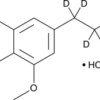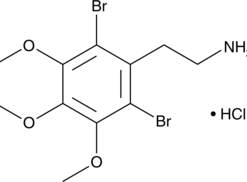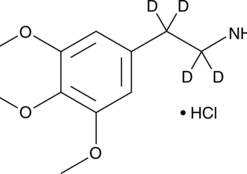3,4-MDMA-d5 (hydrochloride) (CRM)
$40.00 – $120.00
3,4-MDMA-d5 (Hydrochloride) (CRM): A Detailed Overview
Introduction to 3,4-MDMA-d5 (Hydrochloride) (CRM)
3,4-MDMA-d5 (hydrochloride) is a stable isotope-labeled version of 3,4-MDMA, a psychoactive substance commonly used in both recreational and therapeutic contexts. The “d5” designation indicates that the compound is deuterated—meaning it has five deuterium atoms (a heavier isotope of hydrogen) in place of the normal hydrogen atoms in the structure. This alteration allows for more precise detection and tracking of the compound in biological systems and is essential for analytical purposes such as pharmacokinetic studies, toxicology, and drug testing.
As a Certified Reference Material (CRM), 3,4-MDMA-d5 (hydrochloride) is an essential tool for laboratory research, particularly in the fields of forensic science, pharmacology, and drug development. In this article, we will explore the significance of 3,4-MDMA-d5, its applications, synthesis, and where to buy it across different regions including Australia, the UK, Europe, and the USA.
What is 3,4-MDMA-d5 (Hydrochloride) (CRM)?
3,4-MDMA-d5 (hydrochloride) is a deuterated form of 3,4-MDMA, which is the methamphetamine analogue that shares structural similarities with the more commonly known MDMA (Ecstasy). MDMA itself is a well-known psychoactive substance used both recreationally and therapeutically in controlled settings for disorders like PTSD (Post-Traumatic Stress Disorder). 3,4-MDMA-d5 serves as a unique tool for scientists by allowing them to track the metabolism and distribution of the parent compound in various biological systems without interference from naturally occurring compounds.
Deuteration and Its Importance
Deuteration involves replacing hydrogen atoms with deuterium, an isotope of hydrogen that has a neutron in addition to the usual proton. This modification does not significantly alter the chemical properties of the molecule but makes it distinguishable from its non-deuterated counterpart during analysis. In this case, 3,4-MDMA-d5 is the ideal compound for accurate studies in which the tracking of the compound’s behavior and concentration in tissues or fluids is critical.
Since deuterium behaves similarly to hydrogen in chemical reactions but has a different atomic mass, it is detectable through mass spectrometry and nuclear magnetic resonance (NMR) spectroscopy, making it highly useful for pharmacokinetic studies, especially those that involve high-precision analysis.
Applications of 3,4-MDMA-d5 (Hydrochloride) (CRM)
3,4-MDMA-d5 is primarily used in scientific and pharmaceutical research, specifically in the fields of pharmacology, toxicology, and drug testing. Here are some of its key applications:
1. Pharmacokinetics and Metabolism Studies
The introduction of deuterium into 3,4-MDMA allows for accurate tracking of the drug’s metabolism in the body. Researchers can use 3,4-MDMA-d5 to observe the drug’s distribution, absorption, metabolism, and elimination (ADME) processes, all of which are critical in understanding how the compound behaves in humans or animal models. By analyzing the labeled compound, scientists can gain insights into the half-life, stability, and metabolite profiles of MDMA, which helps in assessing its safety and efficacy for therapeutic uses.
2. Drug Testing and Toxicology
Forensic toxicologists use 3,4-MDMA-d5 in controlled settings to analyze the presence of MDMA and its metabolites in biological samples. By comparing the mass spectrometry peaks of the labeled compound and the non-labeled MDMA, toxicologists can detect even trace amounts of the drug in urine, blood, or hair samples. This technique is especially useful for distinguishing between naturally occurring compounds and those administered to individuals, providing more accurate results in drug testing scenarios.
3. Development of MDMA-based Therapeutics
Since MDMA has shown promise as a treatment for PTSD and other psychiatric disorders, the use of 3,4-MDMA-d5 plays a crucial role in the development of MDMA-based therapeutics. With the precision that isotope labeling provides, researchers can monitor the pharmacokinetics and pharmacodynamics of MDMA analogs in clinical trials. This ensures that compounds are optimized for therapeutic purposes with minimal side effects.
4. Standardization and Calibration in Laboratories
As a Certified Reference Material (CRM), 3,4-MDMA-d5 is used to standardize laboratory instruments such as mass spectrometers, ensuring their accuracy. CRMs are essential for calibration and validation of analytical procedures, and 3,4-MDMA-d5 provides a reliable reference for both research and quality control labs in the pharmaceutical, forensic, and environmental sectors.
Synthesis of 3,4-MDMA-d5 (Hydrochloride) (CRM)
The synthesis of 3,4-MDMA-d5 (hydrochloride) requires specialized chemical techniques to incorporate deuterium atoms into the MDMA structure. The process typically begins with a precursor molecule that is modified using deuterium-labeled reagents. Here’s a breakdown of the general steps involved in its synthesis:
1. Deuterium Incorporation
The first step is to introduce deuterium atoms into the MDMA molecule. This can be achieved using deuterated reagents or through a synthetic pathway that selectively incorporates deuterium into the molecule. Deuterium is typically introduced into the hydrogen positions of the amine or methylenedioxy groups, which are the key functional parts of MDMA.
2. Reaction Conditions
The synthesis is carried out under controlled conditions, often using deuterated solvents or specialized catalysts that ensure the integrity of the deuterium incorporation. The reaction must be carefully monitored, as the chemical behavior of deuterium-labeled MDMA should closely mirror that of its non-deuterated counterpart to maintain its effectiveness in metabolic and pharmacological studies.
3. Isolation and Purification
Once the synthesis is complete, the product is purified through standard laboratory techniques such as recrystallization, chromatography, and distillation. These methods ensure the separation of 3,4-MDMA-d5 from any residual starting materials or by-products.
4. Characterization
After synthesis, the compound is thoroughly characterized using methods like NMR spectroscopy, mass spectrometry, and high-performance liquid chromatography (HPLC) to confirm the incorporation of deuterium and to verify its purity. Only when the compound meets the required standards for accuracy and purity is it certified as a reference material for laboratory use.
Global Availability of 3,4-MDMA-d5 (Hydrochloride) (CRM)
3,4-MDMA-d5 (hydrochloride) (CRM) is available from various chemical supply companies and research material suppliers worldwide. It is essential for scientists in pharmaceutical research, forensic toxicology, and other related fields to source high-quality isotopically labeled compounds for their studies. Below is an overview of where to buy 3,4-MDMA-d5 in different regions.
Buy 3,4-MDMA-d5 in Australia
Researchers in Australia can purchase 3,4-MDMA-d5 (hydrochloride) from chemical suppliers specializing in isotopically labeled compounds for research purposes. Australian suppliers often stock these compounds in accordance with strict safety regulations and provide global shipping options for clients needing this material for academic or industrial research.
Buy 3,4-MDMA-d5 in the UK
In the UK, certified reference materials such as 3,4-MDMA-d5 are available through a number of reputable chemical suppliers. These suppliers are highly regulated and provide products that meet the standards necessary for forensic testing, clinical trials, and pharmaceutical development. Researchers can easily order from UK-based distributors, ensuring compliance with local laws and safety protocols.
Buy 3,4-MDMA-d5 in Europe
European suppliers, especially in countries like Germany, France, and Switzerland, are prominent in the supply of deuterated compounds for scientific research. For researchers based in Europe, obtaining 3,4-MDMA-d5 (hydrochloride) is simple through established chemical distributors. These suppliers offer access to top-quality isotopically labeled materials for studies on drug metabolism, pharmacokinetics, and toxicology.
Buy 3,4-MDMA-d5 in the USA
However, The United States has a robust market for certified reference materials, including 3,4-MDMA-d5. Various suppliers offer this product to research institutions, forensic labs, and pharmaceutical companies across the country. Furthermore, Many US-based suppliers offer international shipping, ensuring that the material can be used by scientists globally. The convenience of purchasing from domestic suppliers also allows for faster shipping and handling.
Safety and Handling Considerations
When working with 3,4-MDMA-d5 (hydrochloride), researchers must adhere to proper safety procedures to minimize exposure to chemicals and ensure a controlled environment. Here are some essential safety and handling guidelines:
Personal Protective Equipment (PPE)
Always wear suitable PPE, including gloves, safety goggles, and lab coats when handling chemicals like 3,4-MDMA-d5. It is essential to minimize direct contact with the compound to prevent any accidental exposure.
Storage and Handling
Therefore, store 3,4-MDMA-d5 (hydrochloride) in a cool, dry place, away from direct sunlight and incompatible materials. Proper containment and labeling are critical to prevent accidents in the laboratory setting.
Disposal
Additionally, Dispose of waste materials and by-products in compliance with local environmental and safety regulations. Use approved methods for chemical waste disposal to prevent contamination and harm to the environment.
Conclusion
3,4-MDMA-d5 (hydrochloride) (CRM) is a valuable compound for scientific research, especially in the fields of pharmacology, toxicology, and forensic analysis. In addition, The ability to track MDMA’s metabolism and distribution with high precision opens up new avenues for studying the compound’s effects and optimizing its therapeutic potential. Whether you’re involved in drug testing, clinical trials, or academic research, 3,4-MDMA-d5 is an indispensable tool for gaining a deeper understanding of MDMA-related substances.
With its availability in regions such as Australia, the UK, Europe, and the USA, researchers have convenient access to this essential reference material, ensuring the continuation of advancements in drug development and analytical testing. As the demand for MDMA-based therapeutics grows, the role of 3,4-MDMA-d5 will become even more critical in ensuring accurate and safe drug development.
| 3,4-MDMA-d5 (hydrochloride) (CRM) | 100 µg, 1 Gram |
|---|
Be the first to review “3,4-MDMA-d5 (hydrochloride) (CRM)” Cancel reply
Related products
MDMA Research Chemicals
MDMA Research Chemicals
MDMA Research Chemicals
MDMA Research Chemicals
MDMA Research Chemicals
MDMA Research Chemicals
MDMA Research Chemicals





Reviews
There are no reviews yet.